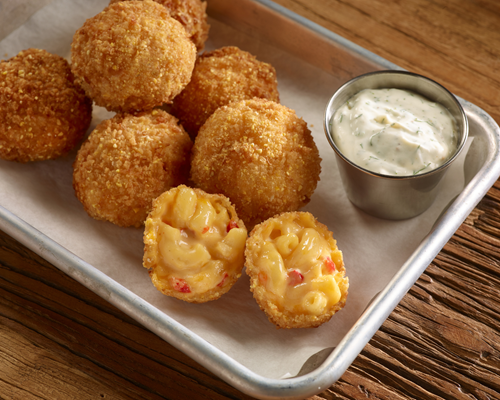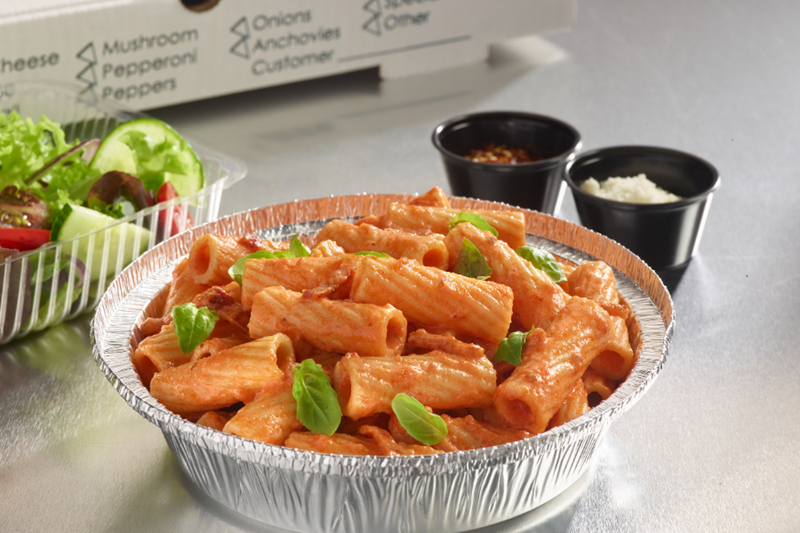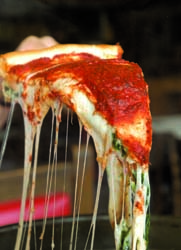 At Mangia Pizza, more than half of the orders entering three Austin, Texas locations request delivery or carryout. That fact in hand, owner Jeff Sayers, a 21-year veteran of the pizzeria business, takes no chances.
At Mangia Pizza, more than half of the orders entering three Austin, Texas locations request delivery or carryout. That fact in hand, owner Jeff Sayers, a 21-year veteran of the pizzeria business, takes no chances.
“It’s simply too significant a chunk of my business not to pay attention,” Sayers says of his delivery and carryout offerings and the packaging they sit in.
Though often relegated to the background, an operation’s delivery and carryout packaging influences both product integrity and consumer perception. Packaging, specifically the pizza box, must both protect the product’s quality and communicate one’s brand message.
“The pizza box is one part art and advertising and one part quality control,” Sayers says. “It’s a real reflection of your pizzeria and your product.”
Just 50 years ago, pizza delivery and carryout comprised a small slice of the pizzeria world. No more. Carryout now accounts for 36 percent of all pizzeria orders, while delivery claims a 31 percent chunk of business. In many ways, one’s pizza box is akin to a home’s curb appeal — fair or not, the principal component that shapes consumer perception.
“As far as the guy answering the door is concerned, that pizza box is your storefront,” says Brian Dickmann, owner of Spokane-based Pizza Rita.
Given the consistent rise of delivery and carryout, packaging has received increased scrutiny. Pizzerias’ diversified menu offerings, including movement into sandwiches, pastas, wings and desserts, has sparked additional attention. Items once placed in bags, such as sandwiches or wings, have been moved into corrugated boxes for heat retention, better quality control and stronger presentation.
“Operators are motivated to drive more sales … and that’s led to more diverse menus and a movement to improve the brand image with packaging,” says Tim Barry of Chicago-based packaging manufacturer Smurfit-Stone.
Amid the plethora of responsibilities handled by an operator, having the right mix of delivery and carryout packaging readily available stands a key task.
While a minimum one week’s supply of soup containers, sandwiches boxes and condiment containers must be on hand, the pizza box leads the must-have list. When looking for a box manufacturer, Sayers listed accessibility as a top priority. He wanted his supply of logo-carrying pizza boxes to run deep and, when needed, be replenished in quick time.
“If we run out of our custom box, then we’ve missed an opportunity to brand our product with the consumer,” he says.
Like many industries, foodservice packaging continues evolving. New production mechanisms arrive, new innovations intrigue and new designs impress. Most changes are driven by end-service users, either operators or dining customers.
Unlike the traditional brown box, which is often viewed as “more natural,” white boxes have gained ground, particularly for those seeking a bolder, sleeker presentation. The graphics on Papa John’s white boxes, for instance, pop with color and style.
“The white boxes have a clean look and present a bolder branding opportunity,” says Barry, predicting that independents will look to mimic Papa John’s style.
In Europe, a trend for lightweight liners and paper with high-performance characteristics has taken hold. It’s a trend filtering into America.
“These trends are totally being driven by the manufacturing process and looking at the most economical ways to benefit the customer with the best available solutions,” says Bob Ford, vice president of ARVCO Containers, a Michigan-based foodservice packaging manufacturer. And lest we forget the unrelenting “Green” movement.
While a litany of upstarts have carried the Green banner and attempted to displace the standard pizza box as the supreme delivery method, most have been dogged by health questions and a tacky appearance. Yet, it is the financial argument that keeps the traditional — and still recyclable — pizza box as the standard.
“You hear everybody talking about ‘Green,’ but at the end of the day it still comes down to dollars and cents and the bottom line,” Ford says.
A significant line item in the books, operators increasingly analyzed packaging costs last year, particularly as food prices climbed.
Prompted by space and freight savings, some operators have dropped the b-fl ute box for an e-flute. While 500 boxes fit in a 60-inch stack of b-flute boxes, the same-sized stack fits 900 sheets of e-flute and 1,300 sheets of f-flute, an emerging option for thin-crust pizzas.
“In switching the flute, the savings can be considerable,” Ford says. “You owe it to your operation to at least investigate other options.”
Sayers found another money-saving method, though one he acknowledges carries a calculated risk. Though he has branded his three top-selling box sizes (10, 12, and 14-inch), he elected not to touch Mangia’s 16-inch box, confident that the extra cost for dye and graphics wasn’t worth the expense for the pizzeria’s least popular size.
With non-pizza products, many operators elect to use clear plastic packaging, a financially volatile product given its petroleum content, yet one seen as “safer” and “classier” than Styrofoam. To get the best deal and to ensure a well-stocked backroom, Sayers suggests ordering up to a month’s supply at one time.
“So long as you have the room, ordering in bulk saves cash and creates a strong back stock,” he says. “It’s a win-win.”
Other operators examine invoices, asking questions of suppliers when an item’s price rises and inquiring about other cash-saving options. That dialogue with a supplier begins with a sincere relationship. Dickmann currently pays 34 cents for his 12-inch boxes, a competitive deal bolstered by the relationship he shares with the supplier.
“Establish a partnership with the supplier and be low maintenance,” Dickman says. “You’ll see that you’ll get paid back with better service and price when you need to be.”
Now and well into the future, Ford says operators should challenge their packaging supplier to discover creative new options.
“New products are out there to help your business,” Ford assures. “Tell (your provider) you want to know about them. That’s a sure-fire way to make sure your packaging needs are being met and that you’re putting your pizzeria’s best foot forward.” ?
Chicago-based writer Daniel P. Smith has covered business issues and best practices for a variety of trade publications, newspapers and magazines.



